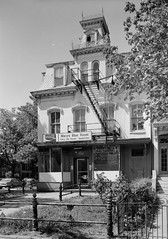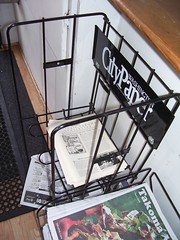May is National Preservation Month...
------
This blog entry is in part based on a similar entry from last May
------

This pathetic looking sign (I added the border) is the sign blank provided to preservation advocates by the NTHP for the 2009 National Preservation Month.
In 2008, the Hill Rag ran a piece, "May is National Preservation Month," stating:
As we celebrate National Preservation Month each May, there is no better time to reflect on why historic preservation matters to us as a community. Perhaps you are already an enthusiast due to your passion for architecture or your interest in community history. Maybe you are the devoted steward of a home here that you wish to see protected, or perhaps your interests are even broader, applying to such issues as city planning, zoning and transportation. It is possible – I concede – that historic preservation would not top your list of priorities at all if asked. However, in this age of global awareness, most everyone is concerned about the environment. And if you care about the environment, then you care about historic preservation.
The hottest topic in historic preservation today is undoubtedly sustainability, with experts and enthusiasts presenting the valid argument that an existing building is the greenest building of all...
So here's my chance once again to reflect on the issues facing historic preservationists in Washington, DC. And thanks to the Hill Rag for writing something to begin with...
1. I disagree that the hottest topic in preservation is sustainability, even though that is all that Pres. Moe of the National Trust for Historic Preservation seems to talk about at conferences. For example, the recent op-ed piece in the New York Times by Richard Moe didn't read right to me, it seemed far too apologetic, and didn't adequately address the issue of historic windows versus replacement windows. See "This Old Wasteful House."
Sustainability as a term is bandied about and people using it often have a narrow focus on specific aspects of environmental issues, rather than a full and complete concern about sustainability in every dimension, including land use, embodied energy, urban systems, etc. From that standpoint, you can't beat preservation and historic preservations have nothing to be apologetic about.
2. The conflict over property rights issues vs. historic preservation, in a variety of respects is the number one issue, and will continue to be for some time.

No historic district sign, Lanier Heights, DC. Photo from DC Metrocentric. The sign here flips around the argument that I use, "it's our neighborhood" and therefore how individuals do things contributes to or diminishes from the neighborhood, and that's a strong justification for preservation protections via regulation.Instead their argument is "it's our neighborhood" and we should be allowed to f*** it up however we want. Really they should be saying "It's my property, f*** you, I can do whatever I want."
3. And the resulting political machinations in the historic preservation process. In DC, legislation has been entered to provide churches with waivers--ironic because churchly mismanagement of historic buildings led to the creation of the local preservation law in the first place--and to make it even harder to create historic districts.
In Montgomery County, Councilmember Michael Knapp has entered legislation which would significantly weaken local law there. See "More than 30 speak against proposed changes to historic preservation law" from the Gazette and this advocacy website.

The demolition of this building, located at the corner of 5th and East Capitol Streets NE by the Capitol Hill Baptist Church, to be replaced by a parking lot, led to the creation of local historic preservation laws, providing for local protections independent of federal historic preservation laws, which only pertain to federal undertakings.
4. In large part, this problem (besides the unfettered desire to do anything with your property, regardless of potential negative impacts on others), derives from the difficulty that many people have with what we might call historic preservation of the "every day" -- preservation of neighborhoods -- in the same way that they understand the preservation of buildings, sites, and places that relate in some way to what we might call "the grand forces of history." Remember that I call preservation of "every day" history the nexus of place, architecture and people (history).
5. The protection of buildings and neighborhoods that are eligible for designation but are not designated and won't be any time soon. This conflict has many dimensions: building up (pop ups) and out (what I call supersizing), inappropriate design of new construction, teardowns for extranormally large (and usually ugly) houses, no protections against demolition generally.
6. Dealing with preservation issues where development pressures are extremely high, which is partly related to #3 but important in and of itself. The failure to protect historic integrity at the St. Elizabeth's Hospital Campus because of "jobs" is a good example of this problem. See "St. Elizabeths could lose historic status" from the Washington Business Journal and this op-ed by NTHP president Richard Moe in the Washington Post, "A Disaster for St. Elizabeths."
For most center cities, preservation is the only long term sustainable strategy for resident retention and attraction. As far as the Central Business District goes, DC is an outlier. Pressures for office space and redevelopment mean that preservation, while essential in most other cities, such as Philadelphia or Baltimore, takes a back seat to development in the core of the City of Washington.
Also see as resources:
-- Affordable Housing and Historic Preservation: The Missed Connection
-- Economic Power of Historic Preservation (Paper)
-- Profiting Through Preservation (report/NY)
-- Contributions of Historic Preservation to Quality of Life in Florida
- Research Report Executive Summary
- Research Report - Technical
7. Related to this is the stewardship of the DC Government with regard to the properties it manages in trust for the Citizens of the District of Columbia, and the pressure to deaccession buildings and sell them off for new development.
8. Dealing with the whole "recent past" question. (i.e., Christian Science Church, MLK Library, etc.) The debacle over the Third Church of Christ, Scientist, is not likely to bode well for how preservation is perceived. Now a local federal judge is not favorable but that is in part because the local federal circuit is not very progressive.
9. Institutions and others desiring exemptions from the preservation laws: i.e., the church question (RLUIPA), the Mt. Pleasant debacle (how to handle modifications to buildings to handle accommodations for the disabled), etc. (This is also related to #2)
10. And why doesn't Marc Fisher, the columnist for the Washington Post, appreciate historic preservation, when there is no question that for the almost 40 year period in which most people with choices abandoned the center city, preservationists were the urban pioneers and/or the people who saved the city for the latecomers to enjoy today. Every thing he writes about preservation (such as "Chevy Chase DC Rejects Historic Status" or "Human Dignity Also Needs to Be Preserved") is negative, and though I like his writing generally, misleading, or at the least, inadequately nuanced. (Part of the problem is that the column and Marc is focused on the individual, rather than systems and processes and the overall impact of decisionmaking, what is called "death by one thousand cuts." You don't notice things when it happens one at a time.)
11. Preservation isn't just for whitey either.
From a past blog entry (Historic preservation and public history: whose history is history anyway?):
The Post reports the obituary of Theresa Brown, the "Theresa F. Brown Dies at 86; Advocate for Preserving Historic D.C. Neighborhood" -- but the headline in the paper is better "Tenacious Protector of LeDroit Park."
She led the effort to stabilize and improve the LeDroit Park neighborhood of Washington, DC, one that had been home to the city's "upper crust" African-Americans for many decades, but had declined along with other neighborhoods in the city due to population loss and then the impact of the riots.
From the article:
Hammered by the 1968 riots and the flight of both residents and businesses, LeDroit Park took on a shabby appearance. Homes were left vacant, drug dealers moved in, and Howard University's expansion ate away at the edges of the area. Mrs. Brown, who worked for the old Chesapeake and Potomac Telephone Co. and was one of the first black women hired for its Baltimore office, told whoever asked that although she couldn't afford to live in the best neighborhood, she could work to make her own neighborhood the best. So she set to it.
She formed the LeDroit Park Preservation Society and began educating residents about their area's history. The tree-lined streets and landscaped traffic circles remained, as did 50 of the original 64 large homes, featuring beautiful tile roofs and gingerbread trim, expansive chimneys, iron grillwork, solid wood porch columns, bay windows and high ceilings.
In 1974, the neighborhood became an officially registered historic district. Some of her neighbors thought it silly, Mrs. Brown told The Washington Post in 2001. "I didn't care what the neighbors thought," she said. "There weren't enough of them to get in my way. I just kept going."

Theresa F. Brown poses with a child in her beloved LeDroit Park, a neighborhood filled with history. (By James Kenah)
12. The height restriction. I am a hardcore preservationist, I think people know that. But looking at the height restriction objectively, there is no question that continued demand for commercial space downtown, and the inability to build up, means that developers build outward instead.
So what you have happening is the "reproduction of the space" east and southeast of the Central Business District. We're losing historic building stock in what were once neighborhoods.
Soon enough M Street SE and NoMa will look just like K Street NW--an onward spread of 12 story boxy glass buildings. Even the H Street NE corridor is under threat, depending on what happens with the Dreyfus project at 200 H St. NE.
13. Not to mention how undifferentiated property tax policies put smaller commercial properties at risk, especially in neighborhood commercial districts.
14. Local preservation organizational capacity, communications, and the need to attract the next generation of people to the movement. Most of DC's citizens groups have leadership that came to prominence during the time when the city was shrinking, and stabilization of neighborhoods was the most important goal. Now the city is growing, how do we as preservation activists, and how do our preservation organizations respond to this fundamentally different condition and situation?

This rare instance of the Historic Takoma organizational newsletter distributed at a neighborhood coffee shop is an example of something that needs to happen more often. It probably is there to promote ticket sales to the upcoming house tour.

Table at the Sunday Takoma Farmers Market.
Labels: building a local economy, civic engagement, economic development, historic preservation, sustainable land use and resource planning



0 Comments:
Post a Comment
<< Home